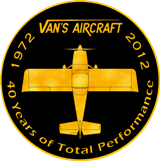
Ready for Final Riveting
Once the new trim spar arrived, I was able to finish the skin prep and prime both the skin and the new trim spar. Once the primer dried, I then clecod the elevator back together. Here you can see it is all ready to be finished riveted. I should be able to reach most, if not all, with my squeezer. I love that tool. It makes fast work of rivets.

Elevator Done, Trim Tab Hinge to Go!
Here is the elevator riveted together. I think it took me all of about 30 minutes to get this far. I also made the bends in the trim tab. I see now why people dread the left elevator. I had some real trouble keeping my bending blocks from slipping when trying to make the bends. Despite that fact, I think it turned out AOK. I scuffed up the skin in the process however. Since I am painting anyway, I figured I would simply scuff the whole tab now.
Once the tab was match drilled and dimpled, I primed the inside and the faying surfaces of the end tabs and set it aside to dry. I then went to work fabricating the hinge for the tab an the elevator. I was excited at the progress I was making and went to town.
I wanted to make sure that a complete barrel of the the elevator side would be located at the most inboard end. This also makes a complete barrel at the outboard end as well. I figured that this would limit any twisting forces that “could” occur, true or not. I marked the inboard edge of the trim tab side with the inboard edge of the trim tab. I did not however, do the same on the inboard side of the elevator half of the hinge. I simply cut it off flush with the last barrel and figured that would be good. I was wrong.
I positioned the trim tab to the elevator and clamped on the hinge and match drilled both halves to the respective parts. The trim tab half went just fine. I clecod it on and went on with the elevator half. After match drilling the hinge and removing it, I saw something that concerned me a little. The most inboard hole was busting the 2Xdia edge distance and really (and I mean really) close to being inside of the 1.5Xdia edge distance rule. I consulted a few smarter folks and they said I would likely be OK to rivet it on as is. So I did.
I finished the trim tab, inserted the hinge pin, stepped back and admired my nearly finished elevator. I typically do an after rivet smash inspection and looked again at the most inboard rivet on the elevator half. I just did not like it. It WAS too close to the edge. I also thought about where the most force would be transferred to the hinge. Since that is soooo close to where the trim servo actually applies the force to the trim tab, I bit the bullet and removed the elevator side hinge. I know, a whole row of rivets for one perceived mess up. I did not want the hinge to possibly tear out over time. After all, it is my plane and I needed it to be right, not close enough here.
I now needed to replace the hinge. I first called around to fellow builders and A&P’s to see if they had any AN257-2 hinge. Turns out, it is not common. Not to mention, after some looking, the only AN257-2 hinge on the plane is right here. Guess it was time to order one. I checked Vans’s and Aircraft Spruce. Turns out for the same money and probably the same shipping, I could get 3 feet of #2 hinge from Aircraft Spruce over 18″ from Van’s. Both would arrive the same day, so order was placed at Aircraft Spruce. You can always use extra at the same cost. All in all, it was a great build day and a good learning experience.


































